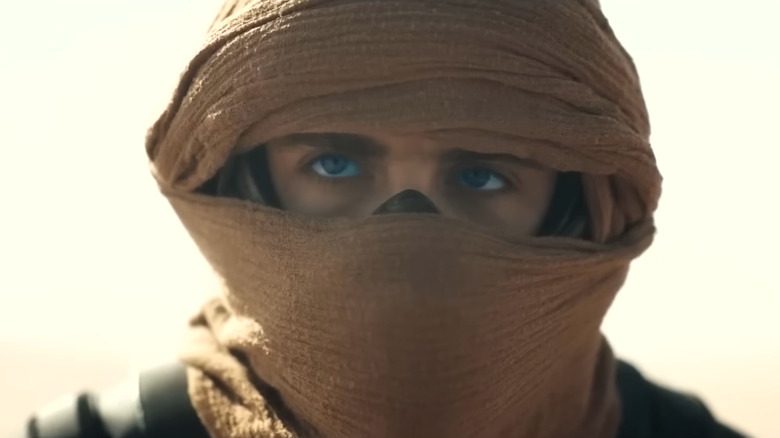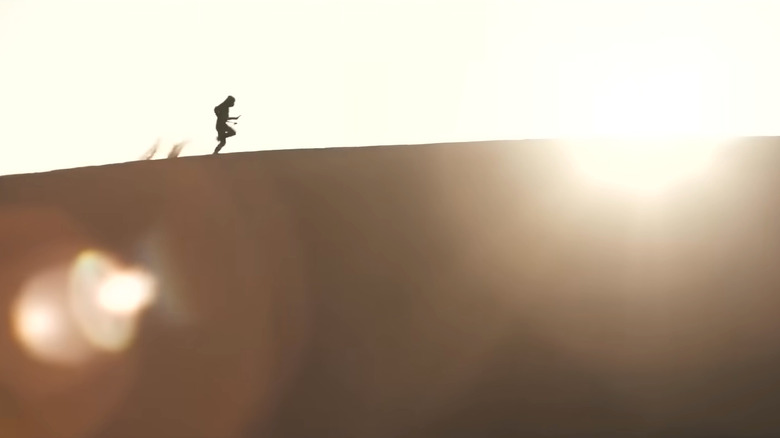Dune 2 Director Denis Villeneuve Wanted 'Boringly Realistic' Camera Work For A Key Sequence
We may receive a commission on purchases made from links.
With the recent release of "Furiosa," a desert-centric movie with same vibrant colors as its predecessor, "Mad Max: Fury Road," it's not uncommon to see people throwing shade on Denis Villeneuve for his "Dune" movies' color schemes and camerawork. Compared to "Furiosa," the "Dune" films can often look surprisingly colorless. It's hard not to wonder if they should've gotten a bit crazier with it.
Of course, if you think about the issue for a little bit longer, it's easy to see the reasoning behind the more muted color scheme in "Dune," as well as its more grounded directing style. This series is more cerebral and politically-oriented than "Mad Max," not to mention that "Part Two" has multiple sequences (like the entire Harkonnen planet detour in the second act) that prove the franchise's definitely capable of stunning visuals. Sometimes there's more that goes into the color grading of a scene than simply what looks pretty, and Villeneuve understood this well.
Most notably, Villeneuve brought this mindset into the "Dune: Part Two" sequence where Paul (Timothée Chalamet) rides a worm for the first time. For a scene that sure sounds ridiculous on paper, it's easy to imagine the movie depicting it in a more bombastic, over-the-top light. Instead, Villeneuve chose to depict in as "boring" a manner as possible, to better create the illusion that this is a real thing we're watching, not the live-action cartoon that the "Mad Max" movies often feel like. (No disrespect towards "Mad Max" intended here; those movies are amazing.)
As Villeneuve explained in the recent "Dune" behind-the-scenes companion book, "The Art and Soul of Dune: Part Two," his chief priority with the sand-riding scene was "anchoring the story in realism."
Villeneuve wanted Dune 2's sandworm scene to look like a documentary
"Keep it grounded," Villeneuve explained, recounting his approach to the scene. "When you're filming the worm from far away, do it in a documentary style, with long lenses. I want the camera movements to be as boringly realistic as possible, because it does something to the brain when you feel that the point of view is real."
The result was a scene that's more immersive than a badass version of the sequence could ever be. It's a sequence where much of the frame is covered in sand flying all over the place, often obstructing the view of what Paul's actually doing. We also barely get to see the worm, as its both covered in sand and mostly only shown from Paul's vantage point. It's an approach that might feel disappointing to any giant worm fans in the audience, but it also went a long way in selling the illusion.
It's hard to argue with the finished product, a scene that looks (and sounds) amazing, and which even brought some longtime fans of the books to tears. "When I saw this in IMAX Thursday, there was an old man crying near me," reads the top comment on the official YouTube clip. "He said [he] read the first 'Dune' back in the '60s and he was so grateful to have lived long enough to see Paul ride the sandworm in a way he envisioned his entire life."
It may not have been as colorful as the average "Furiosa" action sequence, but for fans who've waited decades for the movies to capture the wormriding experience, it was just cathartic to see it depicted in a realistic, believable way. Now lets hope "Dune: Messiah" finally answers the question of how exactly the Fremen manage to get off the worm.

